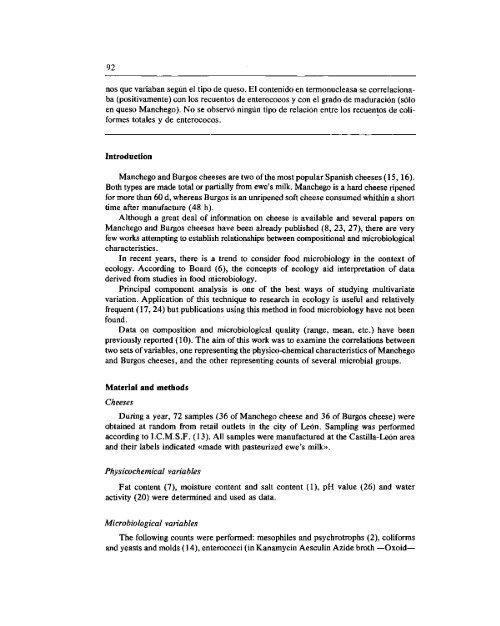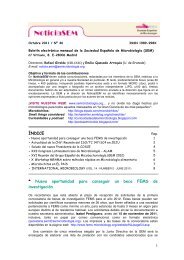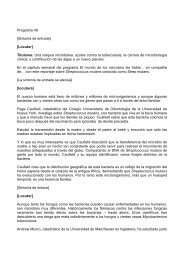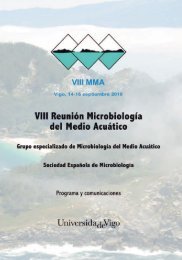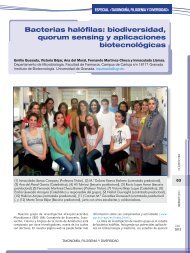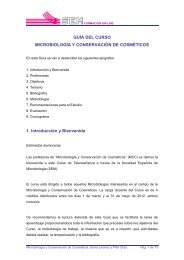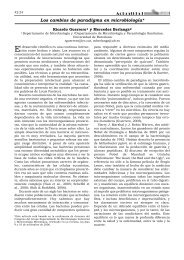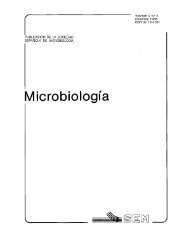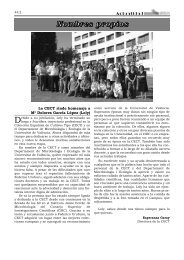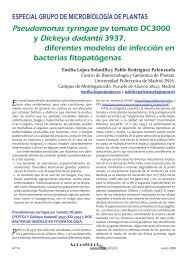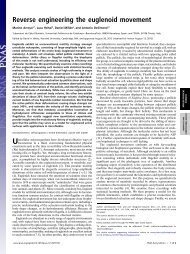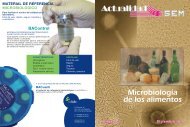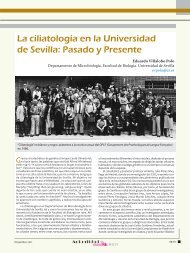Vol. 3 núm. 2 - Sociedad Española de MicrobiologÃa
Vol. 3 núm. 2 - Sociedad Española de MicrobiologÃa
Vol. 3 núm. 2 - Sociedad Española de MicrobiologÃa
You also want an ePaper? Increase the reach of your titles
YUMPU automatically turns print PDFs into web optimized ePapers that Google loves.
92nos que variaban según el tipo <strong>de</strong> queso. El contenido en termonucleasa se correlacionaba(positivamente) con los recuentos <strong>de</strong> enterococos y con el grado <strong>de</strong> maduración (sóloen queso Manchego). No se observó ningún tipo <strong>de</strong> relación entre los recuentos <strong>de</strong> coliformestotales y <strong>de</strong> enterococos.IntroductionManchego and Burgos cheeses are two of the most popular Spanish cheeses (15, 16).Both types are ma<strong>de</strong> total or partially from ewe's milk. Manchego is a hard cheese ripenedfor more than 60 d, whereas Burgos is an unripened soft cheese consumed whithin a shorttime after manufacture (48 h).Although a great <strong>de</strong>al of information on cheese is available and several papers onManchego and Burgos cheeses have been already published (8, 23, 27), there are veryfew works attempting to establish relationships between compositional and microbiologicalcharacteristics.In recent years, there is a trend to consi<strong>de</strong>r food microbiology in the context ofecology. According to Board (6), the concepts of ecology aid interpretation of data<strong>de</strong>rived from studies in food microbiology.Principal component analysis is one of the best ways of studying multivariatevariation. Application of this technique to research in ecology is useful and relativelyfrequent (17, 24) but publications using this method in food microbiology have not beenfound.Data on composition and microbiological quality (range, mean, etc.) have beenpreviously reported (10). The aim of this work was to examine the correlations betweentwo sets of variables, one representing the physico-chemical characteristics of Manchegoand Burgos cheeses, and the other representing counts of several microbial groups.Material and methodsCheesesDuring a year, 72 samples (36 of Manchego cheese and 36 of Burgos cheese) wereobtained at random from retail outlets in the city of León. Sampling was performedaccording to LC.M.S.F. (13). All samples were manufactured at the Castilla-León areaand their labels indicated «ma<strong>de</strong> with pasteurized ewe's milk».Physicochemical variablesFat content (7), moisture content and salt content (1), pH value (26) and wateractivity (20) were <strong>de</strong>termined and used as data.Microbiological variablesThe following counts were performed: mesophiles and psychrotrophs (2), coliformsand yeasts and molds (14), enterococci (in Kanamycin Aesculin Azi<strong>de</strong> broth —Oxoid—


